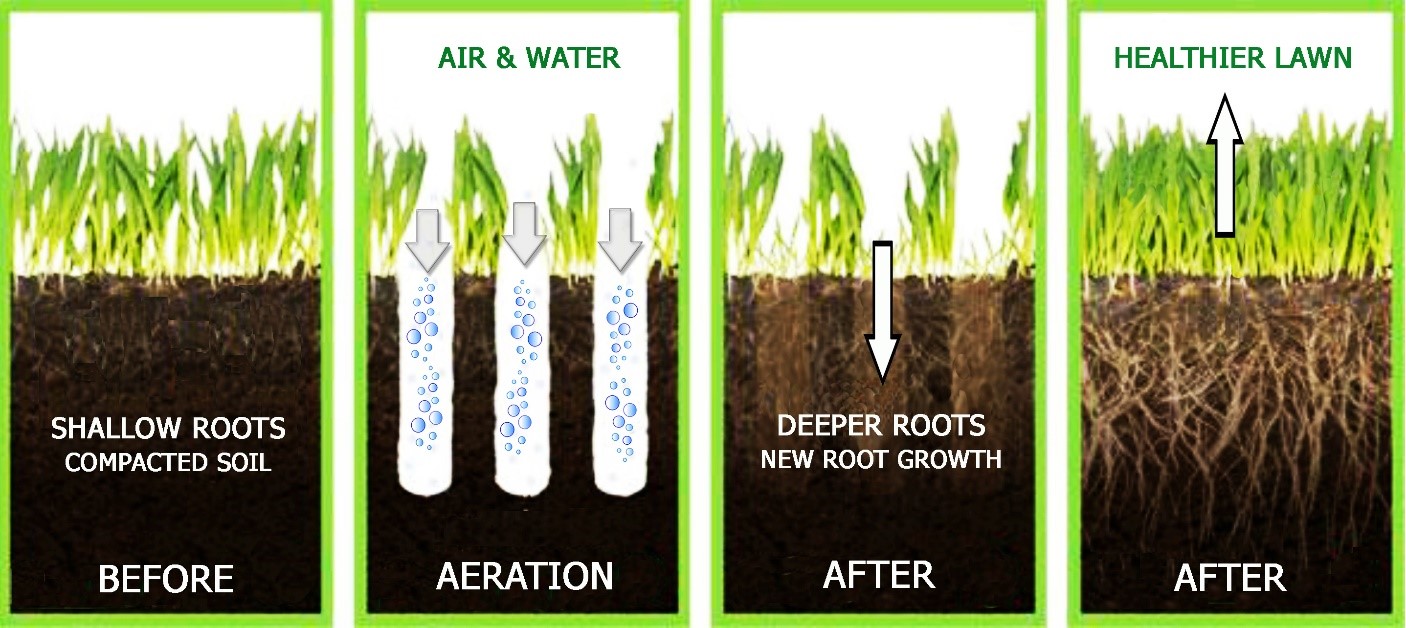LAWN AERATION
Removing small cores of soil from your lawn reduces soil compaction and promotes root growth for healthier grass!
WHAT IS AERATION?
Technically speaking, aeration is the naturally occurring process of air exchange between the soil and its surrounding atmosphere. Practically speaking, aeration is the process of mechanically removing small plugs of thatch and soil from the lawn to improve natural soil aeration. It’s commonly called “core aeration” in the lawn service industry, and you may have heard of it as soil cultivation (coring, spiking and slicing). Most homeowners simply call it aeration.
LAWN AERATION
Removing small cores of soil from your lawn reduces soil compaction and promotes root growth for healthier grass!
WHAT ARE THE BENEFITS OF AERATION?
Core aeration can help make your lawn healthier and reduce its maintenance requirements through these means:
Improved air exchange between the soil and atmosphere.
Enhanced soil water uptake.
Improved fertilizer uptake and use.
Reduced water runoff and puddling.
Stronger turfgrass roots.
Reduced soil compaction.
Enhanced heat and drought stress tolerance.
Improved resiliency and cushioning.
Enhanced thatch breakdown.
WHY IS AERATION NECESSARY?
Compact soil prevents grass from establishing a healthy root system and keeps water and fertilizer from reaching the roots.In most home lawns, fertile topsoil may have been removed or buried during excavation of the basement or footings, forcing grass to grow in subsoil that is more compact, higher in clay content and less likely to sustain a healthy lawn.Walking, playing and mowing will compact soil and stress lawns. Raindrops and irrigation further compact the soil, reducing large air spaces where roots readily grow. Compaction is greater on heavy clay soils than on sandy soils, and it is greatest in the upper 1 to 1 1/2 inches of soil.Aeration can help relieve soil compaction, allowing your grass to grow deeper roots and make better use of water and fertilizer.
HOW OFTEN SHOULD LAWNS BE AERATED?
Most home lawns benefit from annual aeration. Heavily used lawns, or those growing on heavy clay or subsoils may need aeration twice a year. Golf fairways, sports turf and municipalities may need aeration three to five times per year depending on the amount of use. Again, turf responds best when tine spacing is closer and penetration is deeper.
WHAT CAN YOU EXPECT?
Immediately after aeration, your lawn will be dotted with small plugs pulled from the soil. Within a week or two, they break apart and disappear into the lawn.About 7 to 10 days after aeration, the aerification holes will be filled with white, actively growing roots – a sign that the turfgrass is receiving additional oxygen, moisture and nutrients from the soil.On compacted soils and on lawns with slopes, you should see an immediate difference in water puddling and runoff after irrigation or rainfall. After aeration, your lawn should be able to go longer between waterings, without showing signs of wilt. With repeat aerations over time, your lawn will show enhanced heat and drought stress tolerance.Remember, most lawns benefit from annual aeration. And while you shouldn’t expect miracles, especially with poor soil, lawns that receive this care will be healthier, more vigorous, easier to maintain and have fewer pest problems.


